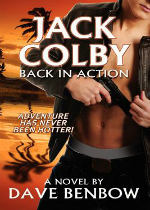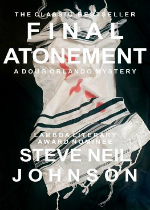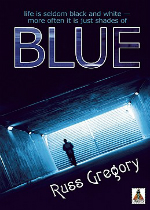GunnShots: Winter 2012
Author: Drewey Wayne Gunn
January 29, 2012
Fall saw a number of gems for mystery fans. Garry Ryan’s new Detective Lane novel and David Lennon’s new Quarter Boys mystery are topnotch. A first novel by Russ Gregory, though it was initially harder-going, kept me engrossed once I got into it. The sequel to Ralf König’s graphic novel about NYPD’s detective Luigi Macaroni has finally been translated. These are the works I am featuring in this column.
But there are many others for readers to enjoy. Sam Cameron has turned out an engaging YA novel, Mystery of the Tempest (Bold Strokes, Nov. 2011), a sort of riff on the Hardy Boys. Twins, one of the boy sleuths is a closet case, the other is a straight Casanova. The case itself begins when a luxury yacht is mysteriously blown up, and then develops in unexpected ways.
Visakesa Chandrasekaram’s political crime novel Tigers Don’t Confess (Frog Books, Aug. 2011), among its multitude of characters, includes two lovers caught up in the Sri Lankan civil war during the early 1990s. Josh Lanyon knows as much about detective fiction as any living gay mystery writer. The second in the Holmes & Moriarity cases, All She Wrote (Samhain, Oct. 2011), plays all sorts of literary games. Set at a mystery writers’ workshop, narrated by a mystery writer, and involving his mentor (who says someone is trying to murder her), the puzzle looks back to the golden age of cozies. Mark Richard Zubro fans will welcome the tenth in the Paul Turner series. Detailing an investigation into the murder of a corrupt police officer at a leather circuit event in Chicago, Black and Blue and Pretty Dead, Too (MLR, Nov. 2011) depicts as unsavory an array of crooked policemen as one could ever dread to meet.
A whole pile of mysteries arrived before my December 22 deadline, but I have not had time to read them. Jack Colby: Back in Action (Palaria Publishing, Sept. 2011) seems a most appropriate title for Dave Benbow’s return after too long a hiatus. Sandy Frances Duncan and George Szanto give us their third Islands Investigations International mystery, Never Hug a Mugger on Quadra Island (TouchWood, Sept. 2011, hardback). Diana Gabaldon’s fifth volume in the Lord John Grey series, The Scottish Prisoner (Delacorte Press, Nov. 2011, hardback), is set in 1760 in England. Dorien Grey is now at volume fourteen in his Dick Hardesty series with The Peripheral Son (Zumaya Boundless, Oct. 2011). And Murder on Mt. Royal (Stonefield, Oct. 2011) joins three earlier adventures in the disarming Jesse Ashworth series by Stephen E. Stanley.
There are two exciting reprint series: Vincent Lardo’s fine 1987 murder mystery, The Mask of Narcissus, has just been republished (MLR Press, Nov. 2011), with promise of his gothic romance, China House, 1983, and a novel of intrigue, The Prince and the Pretender, 1984, to come. And Steve Johnson has reprinted his two outstanding Doug Orlando novels — his Lammy finalist, Final Atonement, 1992, and False Confessions, 1993 (Clutching Hand Books, Aug. 2011). It was a loss when he quit publishing. (If anyone has information about Johnson, I would appreciate hearing from you.)
Robert Gaston’s unpublished film scripts have, for some reason, never received the accolades I think they deserve. His third film, Flight of the Cardinal, an inverted mystery/thriller released in 2010, has just come to DVD (Water Bearer Films, Dec. 2011). Set at a lodge near the Smoky Mountains National Park (and shot on location), it shows the machinations of a young psychopath bent on using and destroying the lodge keeper, a vulnerable gay man with a troubled past. I found it thoroughly engrossing. David J. Bonner stars as the dangerous schemer and Ross Beschler as his intended victim become amateur sleuth.
Learning to Cope: The Singular Detective Lane
I have met Garry Ryan only through his books and emails. But that’s enough to convince me that I’d like to have a coffee with the man. He comes across as sane, passionate, informed. And it does not hurt that he is one of the best writers we have in or out of the mystery field. His plots are always page-turners, and his characters all become people you can genuinely love. Malabarista is his fifth novel in the Detective Lane series set in Calgary, Alberta. Anthony Bidulka and I provide blurbs for it. On rereading mine, I think I am too conservative in my praise.
In all five novels one catches glimpses somewhere or the other of abused children. Lane has dedicated his career to intervening on their behalf. I hesitate always to ask authors for personal details. But something I said in an email elicited a revealing response from Ryan. He has given me permission to quote him. He wrote:
There’s a painting that hangs on the wall in my house. One of my students created it. He was an amazing, kind, creative, colourful, human being. Then one day he put his headphones on and walked down the tracks to meet a train. I have a responsibility to the kids to make things better.
Of no surprise to fans of the series, the most prominent abused child in this one is, or was, Lane himself. The adult still carries the scars of his parents’ rejection of the young Lane and his brother’s treachery when they were children. Hints about this past have been building throughout the series, but now we find out more than before about Lane’s childhood, just as all kinds of different pressures threaten to bring his present world crashing down upon him. The juggler of the title (malabarista is Spanish for juggler) is one of the key characters in the novel. But as one reads, one sees that the real juggler in the story is Lane himself.
His career in the Calgary police department is under threat as a result of events in the preceding novel (Smoked). His two children — his own abandoned niece and his husband’s equally abandoned nephew — are picking their way through adolescence. And his husband, Arthur, is diagnosed with breast cancer, the same as killed Arthur’s sister (and a reminder that breast cancer is not gender specific). On top of that, his trusted partner on the job not only has been reassigned but is ordered to head up the investigation into Lane’s alleged misconduct, and a rookie who worked undercover with the RCMP in an investigation of the suspicious activities that brought out Chief Smoke’s displeasure with Lane is now assigned as his new partner.
The case itself involves the discovery of a body in a drying slough. The victim seems to be a particularly vicious Eastern European war criminal. One who escaped his murderous rampages — when still a boy, maimed, one leg amputated — is the juggler. He is one of several possible suspects. A second case intrudes on the investigation. Simultaneously, someone begins threatening Keely Saliba, his new partner, in an escalating series of anonymous verbal attacks that take an ominous turn when a pipe bomb destroys her car. It is not the last explosive device that will go off before Lane, with the help of Keely and Lori, the station’s receptionist, puts the various pieces of the puzzles together.
There are so many things to love about Ryan’s writing. He is superb at evoking images. I shall long remember Lane and his foster son’s run with wild geese. The smell of coffee permeates the novel (in a play on the title, lots of baristas make guest appearances). The sounds of a street fair ring out. The cast of characters include downright villains, but even more people trying to be basically decent human beings. And always, at points in the story droll moments occur to bring a chuckle to the reader. Only in a Ryan novel would a character get goose shit in his ear.
Bidulka’s appreciative blurb, actually a mini-review, is spot on — save in one particular. I questioned Ryan about the discrepancy. It turns out he made a last minute change to the manuscript, one that Bidulka never saw, and Ryan did not see the blurb till the book came out. Thus, when the reader finishes the novel, a little test awaits: what revealing detail was added at the last moment? I also want to praise Natalie Olsen and Kisscut Design for the evocative cover.
Malabarista
by Garry Ryan
NewWest Press
Paperback, 9781897126899, 204pp
September 2011
Learning to Change: The Conflicted Michel Doucette
David Lennon never ceases to surprise. Each of his four books about NOPD cops turned private investigators has a slightly different structure and situates itself in a slightly different place in the mystery genre. Blue’s Bayou leaves New Orleans for a rural murder case set in the Atchafalaya Swamp Basin. If the second novel in the series (Echoes, 2010) was given more to the straight female half of the team, Sassy Jones, this one is Michel Doucette’s all the way (though Sassy retains an active role via cell phone). At the end, Sassy sums up: “You had a pretty eventful week […]. Losing a cousin, gaining a father, dog, and husband, unraveling a mystery, and solving a crime.” It is also the author’s wisest book to date.
It begins with the arrest of Michel’s cousin Verle Doucette on suspicion of murder. He and his dog, Blue, are intercepted by a state trooper as he staggers out of the swamp carrying the naked body of a dead New Orleans prostitute. Convinced that his gentle cousin is incapable of murder, Michel spearheads his own investigation. Learning how much Verle was into protection of the fragile Louisiana wetlands, how much his activities in that direction have alienated the townsfolk, and just how rich he has become off drilling and mineral rights, Michel looks at a number of different interest groups for suspects who might have set his cousin up.
In the process, he must discover whether he can trust and work with the local sheriff. He has to learn to deal with Ruby, “the town’s crazy” who has essentially become Verle’s ward. Two unpredictable small-town closet cases, both potentially dangerous in different ways, must be sorted out and handled. Then there is the unexpected appearance of Michel’s “dead” father. And what is he to do with Verle’s dog, Blue, part Catahoula Leopard Dog?
Michel uses the excuse of needing to learn more about Ruby to travel toBaton Rougeto meet Sassy’s cousinPearl, who grew up in the same town with the strange woman. He secretly hopes to learn gossip about Sassy’s childhood.Pearldelivers on those stories, but living up to her name, she also provides Michel wisdom. She says of his life, “It’s only complicated because you make it complicated. […] Your problem is that you want a guarantee before you’re willing to take a chance. And I hate to tell you this, but there are never any guarantees.” His father offers yet other insights into the cards Michel has been dealt.
Lennon is too wise a writer to effect an immediate transformation in Michel’s character, any more than he allowed such to happen in the earlier novels to Sassy or Chance (a major character in Second Chance). But clearly this novel must be pivotal to the series’ future development. The mystery is enjoyable, keeping me guessing almost to the end, when all but one person has been eliminated as the possible perpetrator. But the characters one meets in Bayou Proche are what kept me up beyond my bedtime in order to finish the book.
Blue’s Bayou
by David Lennon
Blue Spike Publishing
Paperback, 9781466340817, 325pp
September 2011
Learning to Live Again: A Pair in a Killer’s Gunsight
An Austin, Texas, cold case — code name, Blue— reopens. A serial killer, after being dormant for nearly two decades, begins targeting gay men anew. Russ Gregory’s novel chronicles the effect of
the shootings, old and new, on a cluster of friends, on the lead investigators, and on the killer. Told through a kaleidoscope series of vignettes, the narrative pattern is difficult to discern at first. (And the back cover blurb, reproduced on online sites, confuses rather than helps.) The reader should hold on. Once the story begins to coalesce, the novel becomes totally compelling. Even the fact that I’m not sure I put all the pieces together correctly at the end leaves me with a strange sense of satisfaction about the author’s audacious debut. It’s gratifying to see a writer with such confidence that he not only is willing to throw out the formulas about point of view, characterization, and (I think) chronology, but even manages to bring his coup off. As a reviewer, it is irritating that a key tag I would like to add to my description of the characters, one that would gain the book additional readers, is a complete spoiler.
Two major characters are Matt Bell and Thatcher Keeney. They forge a troubled relationship as each conceals from the other key information about their past. Matt was one of the few victims from the first series of shootings to survive. Thatcher’s lover, Adam, was another. Adam, however,
was infected with the HIV retrovirus through one of the blood transfusions he received and died of AIDS complications. Both Matt and Thatcher retreated from the social scene as a result of their experiences; both are now trying to reconnect with others just as the second wave of shootings inexplicably begins. Both men and Matt’s closest friends seem mysteriously to be in the killer’s gun sight. Bill is the third major character — the killer for whom pulling the trigger provides some kind of sexual release. Why? We seem to have a whydunit rather than a whodunit — but the ending to the novel proves that that is not exactly the right label either. And how will Bill be tracked down? Lieutenant Sam Griggs is obsessed with closing the Blue case. FBI Agent Dorothy Bowles creates the killer’s profile to aid him, but will the growing sexual attraction between her and Griggs help or hinder their pursuit?
Blue is a novel about reconciliation and change, about the destructive terror of homophobia, and perhaps by implication a reminder about the need to obey the injunction carpe diem. The novel coming out just as the Republican presidential campaign heated up also gave readers the irony that most of the scenes occur probably less than a mile from the Governor’s Mansion.
Blue
by Russ Gregory
Bold Strokes Books
Paperback, 9781602825710, 248pp
October 2011
Fighting a Homophobic Conspiracy: The Indomitable Luigi Macaroni
The German comic book artist Ralf König published his graphic novel about an openly gay New
York police detective, Luigi Macaroni, Kondom des Grauens, in 1988. A sequel, Bis auf die Knochen followed in 1990. Both are presented as a series of stills from a film noir. A film, a hilarious send up of noir, with a touch of science fiction, was actually made in 1996: Kondom des Grauens, with a screenplay by König and the film’s director, Martin Walz, based on both graphic novels. In 1992 the first volume received an English translation by J.D. Steakley, The Killer Condom. (A slightly revised edition was reissued by Ignite Entertainment in 2009.) Troma released the English version of the film in 1999; it has become a cult classic. But the graphic novel’s sequel languished untranslated until now. König’s English fans will welcome the superb translation, Down to the Bone, made by Jeff Krell, the author of the popular Jayson series.
In the first novel, Macaroni defeats the bio-engineered condom that is snapping off men’s penises (Macaroni is lucky to lose only a finger and one testicle to the genetically created monster). But he never discovers who is behind the nefarious plot. In the sequel, johns who pick up a porn star lookalike find too late that the hustler’s penis is a monster that devours them, their skeletal remains spit out of the hustler’s mouth. This time Macaroni successfully exposes the pleasure-hating, religious fanatic behind the scheme. A member of a Jesus-cult, she has taken it upon herself “to eliminate the most wicked citizens in advance” of Jesus’s second coming, “along with the pope, […] on the 11:30flight from Rome.” The wicked include “those men who engage in fruitless, same-gender sexual relations — which is already an abomination against God — and then compound their sin by using condoms.”
I know! I should have inserted “Spoiler Alert” into the preceding paragraph. But one reads the book for the pleasure of the drawings, the wackiness of the story, the humor provided by the characters, not for the mystery. Readers will either love the books or roll their eyes. I trust there will be a lot more of the former.
Down to the Bone
by Ralf König; translated by Jeff Krell
Ignite Entertainment
Paperback, 9780965632393, 107pp
October2011








